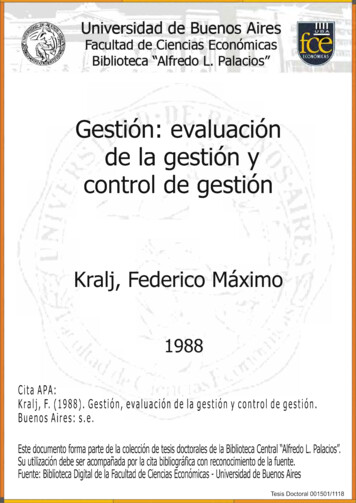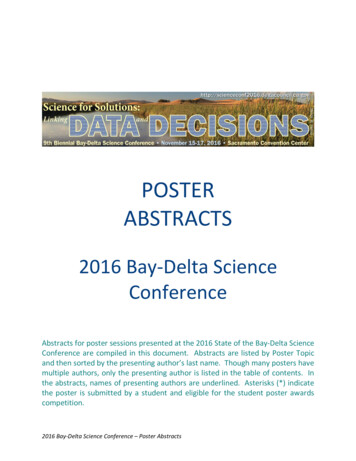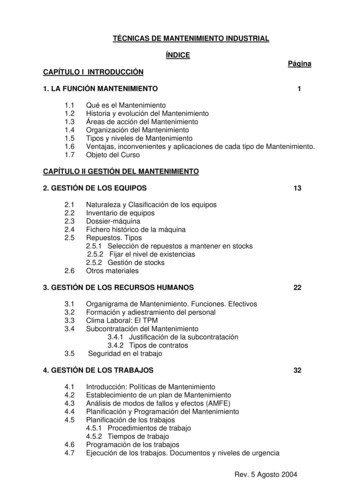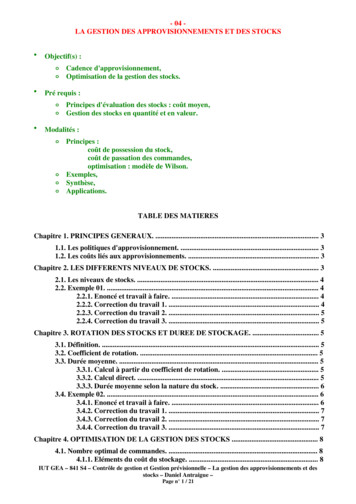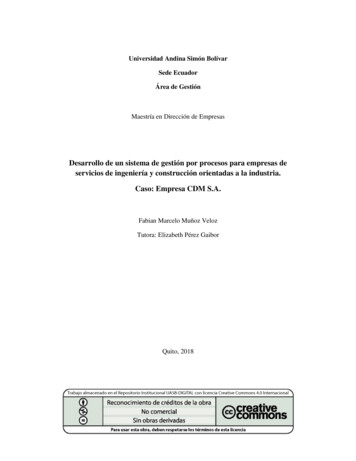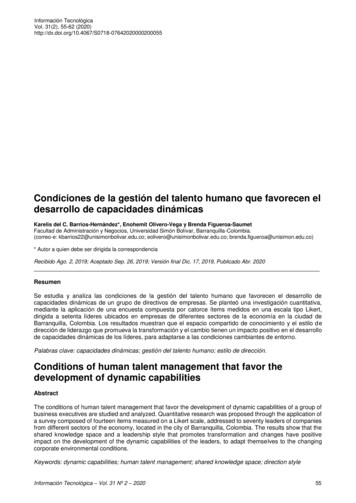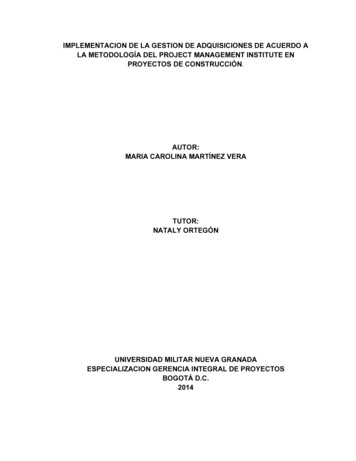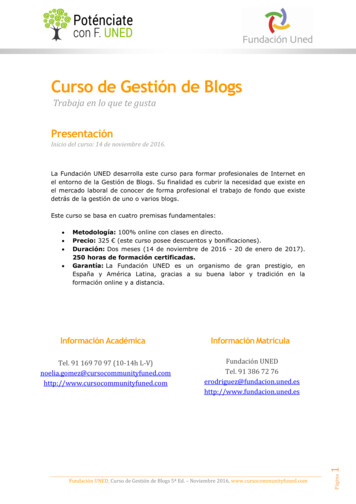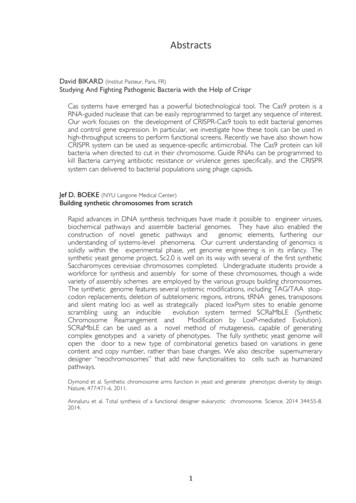
Transcription
AbstractsDavid BIKARD (Institut Pasteur, Paris, FR)Studying And Fighting Pathogenic Bacteria with the Help of CrisprCas systems have emerged has a powerful biotechnological tool. The Cas9 protein is aRNA-guided nuclease that can be easily reprogrammed to target any sequence of interest.Our work focuses on the development of CRISPR-Cas9 tools to edit bacterial genomesand control gene expression. In particular, we investigate how these tools can be used inhigh-throughput screens to perform functional screens. Recently we have also shown howCRISPR system can be used as sequence-specific antimicrobial. The Cas9 protein can killbacteria when directed to cut in their chromosome. Guide RNAs can be programmed tokill Bacteria carrying antibiotic resistance or virulence genes specifically, and the CRISPRsystem can delivered to bacterial populations using phage capsids.Jef D. BOEKE (NYU Langone Medical Center)Building synthetic chromosomes from scratchRapid advances in DNA synthesis techniques have made it possible to engineer viruses,biochemical pathways and assemble bacterial genomes. They have also enabled theconstruction of novel genetic pathways andgenomic elements, furthering ourunderstanding of systems-level phenomena. Our current understanding of genomics issolidly within the experimental phase, yet genome engineering is in its infancy. Thesynthetic yeast genome project, Sc2.0 is well on its way with several of the first syntheticSaccharomyces cerevisiae chromosomes completed. Undergraduate students provide aworkforce for synthesis and assembly for some of these chromosomes, though a widevariety of assembly schemes are employed by the various groups building chromosomes.The synthetic genome features several systemic modifications, including TAG/TAA stopcodon replacements, deletion of subtelomeric regions, introns, tRNA genes, transposonsand silent mating loci as well as strategically placed loxPsym sites to enable genomescrambling using an inducibleevolution system termed SCRaMbLE (SyntheticChromosome Rearrangement andModification by LoxP-mediated Evolution).SCRaMbLE can be used as a novel method of mutagenesis, capable of generatingcomplex genotypes and a variety of phenotypes. The fully synthetic yeast genome willopen the door to a new type of combinatorial genetics based on variations in genecontent and copy number, rather than base changes. We also describe supernumerarydesigner “neochromosomes” that add new functionalities to cells such as humanizedpathways.Dymond et al. Synthetic chromosome arms function in yeast and generate phenotypic diversity by design.Nature, 477:471-6. 2011.Annaluru et al. Total synthesis of a functional designer eukaryotic chromosome. Science. 2014 344:55-8.2014.1
Nico CALLEWAERT (Medical Biotechnology Center, VIB and UGhent, Ghent, Belgium)Rewiring the synthesis of protein-linked glycosylation in eukaryotic biopharmaceuticalexpression hostGlycosylation is the enzymatically catalysed modification of biomolecules withcarbohydrate structures. For secreted and membrane-integral proteins, it is the mostcommon posttranslational modification. Glycan structures characterize the molecularenvironment immediately outside of all cell types and hence have critical functions ininteractions of any cell with its environment (cell-cell, cell-pathogen, cell-molecule). Thefield of glycobiotechnology is concerned with understanding and re-engineering of theseglycosylation-dominated interactions. In particular, the understanding of the syntheticpathways and functions for eukaryotic N- and O-glycosylation, gained over the past fewdecades, has enabled the rewiring of these pathways for the benefit of pharmaceuticalapplications. Based on the conservation of the core pathways between eukaryotes, it hasbeen possible to transfer the efficient synthesis of particular human-specific glycanstructures to other eukaryotes such as yeasts and plants. This is enabling the cost-effectiveproduction of biopharmaceutical proteins with glycosylation patterns customized toparticular therapeutic functionality (e.g. targeting to particular glycan receptors, orcustomized for particular pharmacokinetic behaviour). I will illustrate our work with regardto the production of human IgG-like glycosylation patterns in yeast1, and the productionof mannose-6-phosphate modified lysosomal enzymes for the treatment of humaninherited lysosomal storage diseases2. Whereas these earlier synthetic biology endeavourswere geared towards efficiently synthesising proteins with complex mammalian glycanstructures in other eukaryotes, more recently we have generated mammalian cells andplants in which glycosylation complexity has been reduced to the bare minimum, whilestill being compatible with eukaryotic cell life and protein productivity. This ‘GlycoDelete’technology3,4 opens up many new structural biology and biopharmaceutical applicationsthat are currently being explored in our laboratory.1. Jacobs, P. P., Geysens, S., Vervecken, W., Contreras, R. & Callewaert, N. Engineering complex-type Nglycosylation in Pichia pastoris using GlycoSwitch technology. Nat. Protoc. 4, 58–70 (2009).2. Tiels, P. et al. A bacterial glycosidase enables mannose-6-phosphate modification and improved cellularuptake of yeast-produced recombinant human lysosomal enzymes. Nat. Biotechnol. 30, 1225–1231 (2012).3. Meuris, L. et al. GlycoDelete engineering of mammalian cells simplifies N-glycosylation of recombinantproteins. Nat. Biotechnol. 32, 485–489 (2014).4. Piron, R., Santens, F., De Paepe, A., Depicker, A. & Callewaert, N. Using GlycoDelete to produce proteinslacking plant-specific N-glycan modification in seeds. Nat. Biotechnol. 33, 1135–1137 (2015).Yvonne CHEN (Dpt of Chemical and Biomolecular Engineering, UCLA)Engineering Smarter and Stronger T Cells for Cancer ImmunotherapyT cells expressing chimeric antigen receptors (CARs) specific for the B-cell marker CD19have shown impressive results in the treatment of B-cell malignancies. However, CD19CAR-T cell therapy remains the only robustly effective T-cell immunotherapy to date. Mylaboratory is pursuing several strategies to engineer T cells with stronger anti-tumorfunctions and greater robustness against evasive mechanisms employed by cancer cells. Iwill discuss the development of multi-input CARs to prevent mutational escape by tumorcells, the design of synthetic receptors to counter immunosuppression in the tumormicroenvironment, and the engineering of cytotoxic protein to interrogate intracellulartumor markers. These strategies combine to address critical limitations facing adoptive Tcell therapy, providing potential treatment options for diseases that are otherwiseincurable with current technology.2
Tom ELLIS (Centre for Synthetic Biology and Innovation (CSynBI) and Department of Bioengineering,Imperial College London)Engineering Yeast: Synthetic Modularity at the Gene, Circuit, Pathway and Genome LevelSynthetic biology seeks to understand and derive value from biology via its re-design andsynthesis using engineering principles. After a decade of work to improve DNA assemblyand the control of gene expression, synthetic biology can now tackle cell-scale problems.By applying modular assembly from a kit of parts we can design complex genetic circuitsthat reprogram how yeast grows or endow yeast cells with new metabolic pathways thatproduce valuable molecules such as antioxidants and antibiotics. Or is aim to convertyeast into a prototyping factory for new phenotypes, and this will be aided by a modularsynthetic version of the S. cerevisiae genome that enables evolution of gene content oncue. A part of the global Sc2.0 project to assemble a human-designed yeast genome, ourlab is working on assembling synthetic chromosome XI and has already begun exploitingthe new possibilities that it offers. After 2 years, we’ve nearly completed our 665 kbchromosome and have also developed new lab and software tools that will enable thefuture of genome engineering and yeast synthetic biology.Luis Angel FERNANDEZ (Department of Microbial Biotechnology, National Center of Biotechnology(CNB-CSIC), Campus Cantoblanco UAM, Madrid)Engineering synthetic adhesins and injectisomes in Escherichia coli K-12 to targetmammalian cells for biomedical applicationsOne of the aims of synthetic biology is the design of microorganisms with novel capabilitiesthat could be applied for the development of new vaccines, diagnostic sensors, andtherapeutic interventions for major diseases such as cancer. This presentation will report thedevelopment of two important tools that enable us to precisely program E. coli K-12 bacteriato: 1) adhere to specific target cells; and 2) assemble filamentous injectisomes from type IIIsecretion systems (T3SS) that act as "molecular syringes" for translocation of specific proteinsinto mammalian cells. Firstly, we designed synthetic adhesins based on the display of VHHdomains on the bacterial cell surface with an outer membrane b-domain derived fromintimin of enterohemorrhagic E. coli (EHEC). We generated synthetic adhesins againstdifferent antigen targets expressed on the surface of mammaliam cells and havedemonstrated the specific adhesion of the engineered E. coli bacteria to the targetmammalian cells using in vitro and in vivo models. Using mouse xenotransplants of humantumor cell lines expressing a target antigen, we demostrated that engineered E. coli bacteriacolonize these tumors more efficiently at lower bacterial doses (Piñero-Lambea et al., 2015).Secondly, in order to express functional injectisomes in a non-pathogenic commensal E. colistrain (K-12), we reformatted the operons encoding the structural proteins and chaperonesneeded for the assembly of filamentous injectisomes from enteropathogenic E. coli (EPEC).Our synthetic operon constructs lack secreted effectors and regulatory elements found inEPEC. Five synthetic operons (sLEE1, sLEE2, sLEE3, sLEE4 and escD) were integrated intodifferent sites of the chromosome of E. coli K-12 under the control of an inducible promoter(Ptac) using a marker-less strategy. We demonstrated that the resulting strain, namedSynthetic Injector E. coli (SIEC), assembles functional injectisomes upon induction with IPTGable to translocate proteins into HeLa cells (Ruano-Gallego et al., 2015). Collectively, theseresults open the possibility to target specific mammalian cells with engineered E. coli bacteriaand inject heterologous proteins of interest, such as antibody fragments, immunogens,enzymes, transcription factors, or toxins.3
Piñero-Lambea, C., Bodelón, G., Fernández-Periáñez, R., Cuesta, A.M., Álvarez-Vallina, L., and Fernández, L.Á.(2015). Programming Controlled Adhesion of E. coli to Target Surfaces, Cells, and Tumors with SyntheticAdhesins. ACS synthetic biology 4, 463-473.Ruano-Gallego, D., Álvarez, B., and Fernández, L.Á. (2015). Engineering the Controlled Assembly of FilamentousInjectisomes in E. coli K-12 for Protein Translocation into Mammalian Cells. ACS synthetic biology 4, 1030-1041.Martin FUSSENEGGER (ETH Zürich, Dpt of Biosystems Science and Engineering, Basel)Prosthetic Gene Networks for Biomedical ApplicationsSince Paracelsus’ (1493-1541) definition that the dosing makes the drug the basictreatment strategies have lagely remained unchanged. We continue to use a preciseprescribed dose of a small-molecule drug, a protein therapeutic or a therapeutictransgene to modulate or complement the activity of a disease-relevant target. However,this treatment concept does neither consider the metabolic dynamics nor theinterdependence of the most important pathophysiologies of the 21st century such asobesity, diabetes and cardiovascular disorders. Synthetic biology-inspired prostheticnetworks may act as metabolic prostheses that provide the dynamic interventions, theimmediate pre-disease action and the multi-target capacity required to meet with thetreatment challenges of the future. Prosthetic networks consist of synthetic sensoreffector gene circuits that (i) seamlessly operate in implanted designer cells, (ii) constantlysense, monitor and score metabolic disturbanes in peripheral circulation, (iii) process OFFlevel concentrations of pathologic metabolites, and (iv) coordinate an adjusted therapeuticresponse in an (v) automatic and self-sufficient manner. We will present our latestgeneration of synthetic mammalian gene circuits and provide a few examples of prostheticnetworks operating in animal models of prominent human diseases to highlight thechallenges and impact of synthetic biology on future biomedical applications.Ming HAMMOND (Depts of Chemistry and MCB, UC Berkeley, USA)Illuminating Bacterial Signaling with RNA-Based BiosensorsMy research asks, what can we program RNAs to do in vivo beyond base-pairinginteractions? Thus, I conceived of starting with riboswitches, natural RNA scaffolds thatfold into stable, active structures, and then exploring how to design or evolve newfunctions. Based on this principle, my research group has made novel RNA-based toolsthat are robust and context-independent, including biosensors with high fluorescenceturn-on that function in all bacteria and suicide exons with high gene activation thatfunction in all plants. In this lecture, I will focus on our development of RNA-basedfluorescent biosensors, presenting design principles we have learned, challenges thatremain to be tackled, and finally applications to the study of bacterial signaling that havethe potential to greatly expand our synthetic biology toolboxJim HASELOFF Department of Plant Sciences, University of Cambridge, Cambridge, UK.Synthetic Biology and engineering multicellular systems.Synthetic Biology is an emerging field that employs engineering principles for constructinggenetic systems. It is providing a conceptual and practical framework for the systematicengineering of gene expression and behaviour in microbes, but also shows great potentialfor the engineering of multicellular systems. We have used populations of Escherichia colicells, which exhibit little or no intrinsic coordination of growth, as a model system to study4
physical interactions in multicellular systems. This system effectively isolates the effects ofcell shape, growth, and division on spatial self-organization. Even these very simplesystems show emergent properties, and give rise to striking fractal patterns. Large-scalecellular biophysical models demonstrate that local instabilities are responsible forgenerating the observed self-organising properties of the system, and confirm the need formulti-scale physico-genetic models of cell growth for understanding and engineering multicellul ar systems. We are now exploring a similar approach using a simple plant system,the liverwort Marchantia polymorpha. Marchantia is characterised by morphologicalsimplicity, matched by simple underlying genome structure. Its ease of culture,transformation and analysis make it an ideal system for plant development and syntheticbiology. We have developed a battery of computational, imaging and genetic tools toallow clear visualisation of individual cells inside living plant tissues, and are developing acommon syntax for plant DNA parts that can be used to reprogram metabolism anddevelopment.Biography: Jim Haseloff is a plant biologist working at the University of Cambridge. His scientific interests arefocused on the engineering of plant morphogenesis, using microscopy, molecular genetic, computational andsynthetic biology techniques (www.haseloff-lab.org). He and his group have developed new approaches toRNA engineering, quantitative imaging and gene expression in plants, and promote the potential ofSynthetic Biology as a tool to engineer new feedstocks for sustainable use. He is a director of theOpenPlant Synthetic Biology Research Centre, a collaborative venture between the University ofCambridge and the John Innes Institute and Sainsbury Laboratory, Norwich (www.openplant.org).Ichiro HIRAO (Team Leader and Principal Research Scientist, Institute of Bioengineering andNanotechnology (IBN), Singapore)Genetic alphabet expansion by an unnatural base pair system toward diagnostic andtherapeutic applications using xeno-nucleic acidsStandard nucleic acids comprise four different nucleotide components bearing each of A,G, C or T(U)base as a genetic alphabet. Nucleic acids can be replicated themselvesthrough the complementary base pairings of A–T(U) and G–C, and act as functionalmolecules, such as catalysts and ligands. However, their functionality is restricted by thelimited number of the components, as compared with the 20 standard amino acidcomponents of proteins. If we could expand the genetic alphabet by artificially creating anew unnatural base pair, these extra base components in xeno-nucleic acids mightaugment their functions.Recently, several groups reported different types of unnatural base pairs that function as athird base pair in replication and transcription. Among them, we developed a hydrophobicunnatural base pair between 7-(2-thienyl)imidazo[4,5-b]pyridine (Ds) and a diol-modified2-nitro-4-propynylpyrrole (Px) (Kimoto, M. et al., 2009). Chemically synthesized DNAfragments containing the Ds–Px pair are amplified 1028-fold by PCR corresponding to100 cycles, and more than 97% of the Ds Px pairs survived at the initial positions in theamplified DNA (Yamashige, R. et al., 2012).We applied the Ds–Px pair system to generating Ds-containing DNA aptamers thatspecifically bind to targets. Then, we found that a few hydrophobic Ds bases efficientlyincreased the affinity of the DNA aptamers to target proteins, achieving significantly higheraffinities than those of the conventional DNA aptamers (Kimoto, M. et al., 2013).Furthermore, the aptamers that we obtained can be stabilized against nucleases bymodifying using a mini-hairpin technology that we previously developed (Hirao, I. et al.,1994). Here, I will talk about the unnatural-base DNA aptamer generation for theirapplication to diagnostics and therapeutics.5
Kimoto, M., Kawai, R., Mitsui, T., Yokoyama, S. & Hirao, I. An unnatural base pair system for efficient PCRamplification and functionalization of DNA molecules. Nucleic Acids Res. 37, e14 (2009).Yamashige, R. et al. Highly specific unnatural base pair systems as a third base pair for PCR amplification.Nucleic Acids Res. 40, 2793-2806 (2012).Kimoto, M., Yamashige, R., Matsunaga, K., Yokoyama, S. & Hirao, I., Generation of high-affinity DNAaptamers using an expanded genetic alphabet. Nat. Biotechnol. 31, 453-457 (2013).Hirao, I., Kawai, G., Yoshizawa, S., Nishimura, Y., Ishido, Y., Watanabe, K. & Miura, K., Most compact hairpinturn structure exerted by a short DNA fragment, d(GCGAAGC) in solution: an extraordinarily stablestructure resistant to nucleases and heat. Nucleic Acids Res. 22, 576-582 (1994).Kirsten JUNGPhilipp HOLLIGER (MRC Laboratory of Molecular Biology, Cambridge Biomedical Campus UK)Synthetic geneticsSynthetic biology seeks to probe fundamental aspects of biological form and function byconstruction (i.e. resynthesis) rather than deconstruction (analysis). Synthesis thuscomplements reductionist and analytic studies of life, and allows novel approachestowards fundamental biological questions.We have been exploiting the synthesis paradigm to explore the chemical etiology of thegenetic apparatus shared by all life on earth. Specifically, we ask why information storageand propagation in biological systems is based on just two types of nucleic acids, DNAand RNA. Is the chemistry of life’s genetic system based on chance or necessity? Does itreflect a "frozen accident", imposed at the origin of life, or are DNA and RNA functionallysuperior to simple alternatives.I’ll be presenting recent progress on the development and application of strategies toenable the enzymatic synthesis and reverse transcription and hence replication andevolution of novel synthetic genetic polymers, which we term XNAs. We show that eightdifferent synthetic polymers, based on nucleic acid architectures not found in nature, canalso mediate genetic information storage and propagation [1]. Beyond heredity, wedemonstrate a capacity for Darwinian evolution by the de novo selection of specificligands (XNA aptamers) and catalysts (XNAzymes) based on entirely synthetic backbones[1, 2]. Thus, key hallmarks of living systems, including heredity and evolution are notlimited to DNA and RNA but can be implemented in synthetic polymers and are likely tobe emergent properties of polymers capable of information storage.I’ll also be presenting our progress in the engineering and evolution of RNA polymeraseribozymes towards a general polymerase and self-replication capacity We have discoveredRNA polymerase ribozymes that are capable of the templated synthesis (i.e. transcription)of another simple ribozyme [3] or RNA oligomers exceeding their own size ( 200 nts)[4], a key milestone on the road to self-replication.[1] Pinheiro VB, Taylor AI, Cozens C, Abramov M, Renders M, Zhang S, Chaput JC, Wengel J, Peak-ChewS-Y, McLaughlin SH, Herdewijn P & Holliger P (2012) Synthetic Genetic Polymers Capable of Heredity andEvolution. Science. 336: 341-44.[2] Taylor AI, Pinheiro VB, Smola MJ, Morgunov AS, Peak-Chew SY, Cozens C, Weeks KM, Herdewijn P &Holliger P. (2015) Catalysts from synthetic genetic polymers. Nature, 518: 427-30[3] Wochner A, Attwater J, Coulson A & Holliger P (2011) Ribozyme-catalyzed transcription of an activeribozyme. Science ; 332 : 209-12.6
[4] Attwater J, Wochner A & Holliger P. (2013) In-ice evolution of RNA polymerase ribozyme activity.Nature Chem.; 5 : 1011-8.Kirsten Jung1,2, Wolfram Volkwein1,2, Bastian Viverge1,3, Andreas Reichert1,4,Arne Skerra1,4, Thomas Carell1,3, and Jürgen Lassak1,21Center for Integrated Protein Science Munich, Ludwig-Maximilians-Universität München, D-81377 Munich2Department of Biology I, Microbiology, Ludwig-Maximilians-Universität München, D-82152 Martinsried3Department of Chemistry, Ludwig-Maximilians-Universität München, D-81377 Munich4Biological Chemistry, Technische Universität München, D-85350 Freising-WeihenstephanA synthetic biology approach of translational controlTranslation of proteins with a stretch of consecutive prolines leads to ribosome stalling.To overcome this stop, bacteria depend on a specific translation elongation factor P (EFP), being orthologous and functional identical to eukaryotic/archaeal elongation factore/aIF-5A (1-3). EF-P binds to the ribosome between the peptidyl-tRNA binding site (Psite) and the tRNA exiting site (E-site) and stimulates peptide bond formation. In theiractive form both EF-P and e/aIF-5A are post-translationally modified at a positivelycharged amino acid, which protrudes towards the peptidyl-transferase center. Whilearchaeal and eukaryotic IF-5A depend on hypusination of a conserved lysine, the EF-Pmodification strategies in bacteria vary. In Escherichia coli and Salmonella enterica a lysineof EF-P is extended by β- lysinylation and subsequently hydroxylated, whereas inPseudomonas aeruginosa and Shewanella oneidensis an arginine in the equivalent positionis rhamnosylated (reviewed in 4). In addition to structural constrains of polyprolinestretches, some EF-P dependent proteins require this motif to fine-tune the proteinoutput. Our studies aim to create a synthetic EF-P variant, which is standardized andconstitutively active independent of species-specific posttranslational modifications. Forthis purpose, we replace the conserved lysine with unnatural amino acids, such aspyrrolysine, acetyl-lysine, propionyl-lysine, and butyryl-lysine by using the ambersuppression system. All synthetic variants are tested for functionality in vivo using reporterstrains. In addition, first results are presented of using the amber suppression system incombination with stalling motifs to generate a translational control tool to fine-tune theprotein output.(1) Ude S, Lassak J, Starosta AL, Kraxenberger T, Wilson DN Jung K (2013) Translation elongation factorEF-P alleviates ribosome stalling at polyproline stretches. Science 339, 82-85.(2) Doerfel LK, Wohlgemuth I, Kothe C, Peske F, Urlaub H, Rodnina MV (2013) EF-P is essential for rapidsynthesis of proteins containing consecutive proline residues. Science 339, 85-88.(3) Gutierrez E, Shin B, Woolstenhulme C, Kim J, Saini P, Buskirk A, Dever T (2013) eIF5A promotestranslation of polyproline motifs. Mol. Cell 51, 1-11.(4) Lassak J, Wilson DN, Jung K. (2015) Stall no more at polyproline stretches with thetranslation elongation factors EF-P and IF-5A. Mol. Microbiol. doi: 10.1111/mmi.13233. [Epub ahead ofprint].Sébastien LEMIRE PhD / Tim K. LU (Synthetic Biology Group, Dpt of Electrical Engineering andComputer Science, Dpt of Biological Engineering, MIT)Technologies for engineering the microbiomeUnderstanding the role of the gut microbiome in modulating host health and disease willrequire technologies for localized and long-term monitoring of microbiome and gutfunctions in vivo. Furthermore, new strategies are needed for precise modulation ofmicrobiomes to enable new diagnostics and therapeutics, since existing approaches formodulating the microbiome can have significant off-target effects. Synthetic biology canprovide new tools for studying and manipulating complex microbial communities.7
We have created strategies for engineering commensal gut bacteria, such as Bacteroidesthetaiotaomicron, a major and stable member of the human gut microbiome withsynthetic gene circuits and we demonstrated that they are still functional in mice stablycolonized with the engineered bacterium. This work provides a resource for Bacteroidesgenetic engineering towards future applications as non-invasive diagnostics andtherapeutics in the gut microbiome. Furthermore, we have created technologies for thespecific knockdown of bacteria living in mixed microbial communities. For example, weengineered CRISPR-Cas antimicrobials that kill bacteria based on their genetic signatures.In addition, we have built a technology platform for engineering phage host range, whichenables the creation of well-defined phage cocktails that can kill specific subpopulations ofbacteria within mixed microbial consortia.We anticipate that these strategies will be useful for the targeted knockdown of bacteriain complex microbiomes to understand the functional role of these bacteria or achievetherapeutic effects.Pablo I. NIKEL (Centro Nacional de Biotecnología (CNB-CSIC))Synthetic Morphology Approaches in Pseudomonas putida for Bioremediation ofHaloalkanesBacterial biofilms are known to outperform planktonic counterparts in several types ofwhole-cell biocatalysis processes. The transition between planktonic and biofilm lifestylesof the platform strain Pseudomonas putida KT2440 (as in many other Gram-negativemicroorganisms) is ruled by a regulatory network that processes a large number ofexternal and endogenous cues into different levels of the trigger signal cyclic di-GMP (c-diGMP). This circumstance was exploited for the rational design of a synthetic geneticdevice that supersedes the processes involved in synthesis or degradation of c-di-GMP inP. putida – thus making the bacterium to form biofilms at the user's will. In so doing, thetranscription of either yedQ (encoding a diguanylate cyclase) or yhjH (encoding a c-diGMP phoshodiesterase) from Escherichia coli was artificially placed under the tight controlof a cyclohexanone-responsive expression system. The resulting recombinant strain wassubsequently endowed with a synthetic dehalogenation operon (spanning two genes fromP. pavonaceae encoding haloalkane dehalogenases) and tested for 1-chlorobutanebiodegradation. Upon addition of cyclohexanone to the culture medium, the therebyengineered P. putida cells formed biofilms displaying high levels of dehalogenase activity.These results show that morphologies and physical forms of whole-cell biocatalysts can begenetically programmed while purposely designing their biochemical capacities.Furthermore, the spatial disposition of the bacteria at stake will in fact become an integralpart of the design process of geneticallymanufactured catalysts of the future.Floyd ROMESBERG (Department of Chemistry, The Scripps Research Institute, La Jolla, CA, USA)A Semi-synthetic Organism with an Expanded Genetic AlphabetExpansion of the genetic alphabet to include a third base pair not only has immediateutility for a number of applications, such as site-specific oligonucleotide labeling, but alsoserves as the foundation for an organism with an expanded genetic code. Toward thisgoal, we have examined a large number of different unnatural nucleotides bearing mainlyhydrophobic nucleobase analogs that pair based on packing and hydrophobic interactionsrather than H-bonding. Optimization based on extensive structure-activity relationshipstudies and two screens resulted in the identification of a class of unnatural base pairs thatare well recognized by DNA and RNA polymerases. More recently, we have engineeredE. coli to import the requisite unnatural triphosphates and shown that DNA containing8
the unnatural base pair is efficiently replicated within the cell, resulting in the first semisynthetic organism that stores increased information in its genome.Eriko TAKANO (Manchester Centre for Synthetic Biology of Fine and Speciality Chemicals(SYNBIOCHEM), Manchester Institute of Biotechnology, Faculty of Life Sciences, University of Manchester, UK)Harnessing synthetic biology for the production of high-value chemicalsOur ability to readily sequence complete genomes and to manipulate/re-design them on alarge scale enables the design and construction of organisms with new functionalities ofunprecedented scope (“synthetic biology”). We explore these possibilities in the contextof high-value chemical production. Many microorganisms already have the machinery toproduce diverse bioactive molecules that can be used in
Jef D. BOEKE (NYU Langone Medical Center) . Dpt of Biosystems Science and Engineering, Basel) Prosthetic Gene Networks for Biomedical Applications Since Paracelsus' (1493-1541) definition that the dosing makes the drug the basic . My research asks, what can we program RNAs to do in vivo beyond base-pairing interactions? Thus, I conceived .
